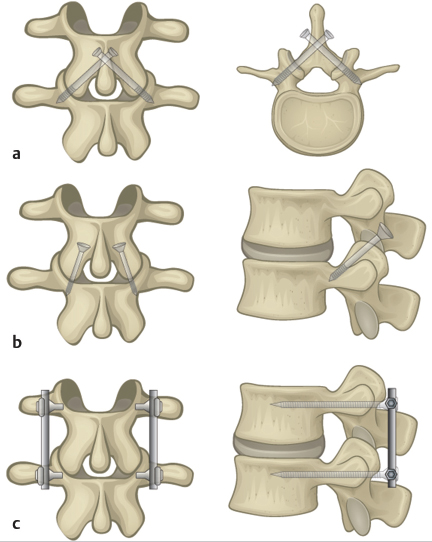7 Facet Screw Systems
7.1 Introduction
The posterior approach for facet screw fixation is described in Chapter 3 Posterior Retractor Systems. Facet screws were developed as an alternative to the standard pedicle screw fixation system.1 By utilizing facet screws as an adjunct to minimally invasive fusion, the safety, feasibility, and overall morbidity associated with standard fixation were all theorized to substantially improve.2 Surgical indications are presented in ▶ Table 7.1.
7.1.1 Facet Screw Components
Facet screws are similar in design to pedicle screws, with variations in body length to accommodate the different approach and point of fixation.1 The “translaminar transfacet” and “transfacet pedicle” techniques were both developed to provide access to the facet joints for appropriate fixation (▶ Fig. 7.1).3 Both techniques have exhibited successful restriction of facet motion; however, there are differences in the type of instrumentation and insertion angle utilized in each technique.1 The translaminar transfacet technique utilizes longer screw lengths with the perceived benefit of increasing mechanical robustness.2 This technique also utilizes a different angle of insertion in order to enter the contralateral lamina and end at the base of the ipsilateral transverse process, potentially increasing the strength of fixation.3,4
7.1.2 Outcomes
Facet screws have exhibited exceptional outcomes when utilized as a method of spinal fixation. These instruments have been demonstrated to induce stability in multiple spinal motion planes, including flexion, extension, and rotation.5 Additionally, translaminar facet screws have been noted to increase the stiffness of spinal motion segments and the associated interbody device.6,7,8 These characteristics are thought to reduce the risk of cage collapse and subsidence.8 Furthermore, by stabilizing the facet joint, facet screws are able to minimize the uncoupling of the facet that occurs from interbody device distraction.7,9 This consequently provides increased stability in extension and axial rotation, which is often weakened from interbody distraction.9 Facet screws also exhibit advantages when compared to other types of spinal instrumentation. Previous studies have determined significant reduction in rates of neurologic injury and cerebrospinal fluid leaks with facet screw fixation in comparison to pedicle screw fixation.10,11 Biomechanically, facet screws often appear to be equivalent to pedicle screws in providing mechanical fixation and stability.5,8,12
Table 7.1 Surgical indications for facet screws
Indications |
• Anterior approach spinal fusion • Posterior approach spinal fusion • Cervical procedures • Thoracolumbar procedures • Degenerative disk disease • Spondylolisthesis • Spinal fracture/dislocation • Spinal stenosis |




